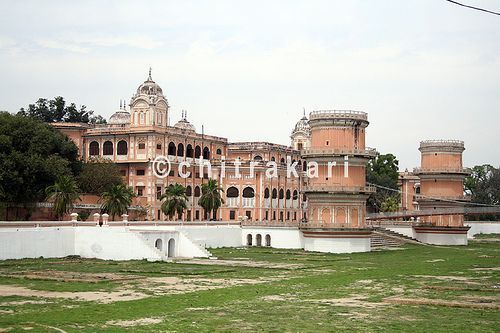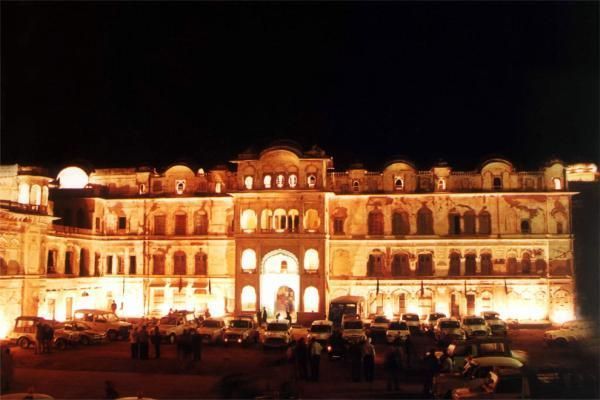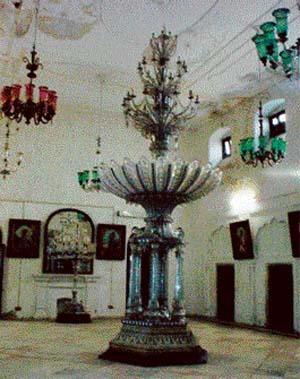harmanjit_kaur
Waheguru Waheguru
Summer Palace of Maharaja Ranjit Singh (1780-1838 AD) , AMRITSAR
It was constructed under the supervision of Fakir Azeez-ud-din and Sardars Lehna Singh and Desa Singh Majithia, nobles of the Lahore Darbar at a cost of Nanak Shahi Rs. 1,25,000/- Originally, laid in a garden spreading across 84 acres of rare plants, trees and flowers, surrounded by a boundary wall, 14 feet high and a moat all around it, this beautiful palace had also several equally beautiful clusters of structure which were converted into clubs and libraries, the lawns around them into tennis courts by the British.
The entrance of the palace called the Darshani Deori is unique in design. It has four two storied towers in the cardinal directions. There are two tanks, the one connecting the palace with water channels fitted with fountains and the other with the air-conditioning pipes circuiting the outer walls and the bathing tanks of the double storied part of the residence. Some of the paintings and the mirror work on the roofs is still extant.
Qila Mubarak Patiala
The Qila (fort) was also the residence of Patiala dynasty. The residential part was called Qila Androon or the Inner Fort. Its living apartments have names like Jail Walla Palace for royal prisoners, the Moti (pearl) Palace, the Sheesh (mirror work) Palace, the Rajmata (Queen Mother) Palace, the Palace of Colours, the Palace of the Moon. The recreational structures were called the Putli (Puppet) Ghar and Bagh Ghar or the Garden House. Its richly painted chambers are peerless.
Most astonishing of all, the Palace is fitted with underground sewerage system and has a cool room connected with a tunnel which brings cool air from the basement. Lassi Khana-the royal kitchen used to feed 35,000 people of all ranks everyday.
The Sheesh Mahal, Patiala
It was built in the reign of Maharaja Narinder Singh (1845-1862) in a forest with terraces, gardens, fountains and an artificial lake. With two watching towers in the north and the south the lake is connected to Banasar Ghar, where all type of stuffed animals are kept and Sheesh Mahal, the residential palace with a suspension bridge which is a copy of the Lakhsman Jhula at Rishikesh.
Part of the three storied building is inset with pieces of reflecting mirrors and a large number of wall paintings depicting scenes from Bhagwat Puran and portraits of the Sikh Gurus. The palace has galleries displaying antique paintings, bronzes, sculptures and portraits of the Maharajas of Patiala. The highlight is the gallery which displays the world's largest collection of medals, decoration and orders of various countries.
The best and most impressive Palace in the Punjab was that of the ex-Ruler of Kapurthala which has now been converted into a Sainik School. The palaces of Nabha and Faridkot are not open to public.
It was constructed under the supervision of Fakir Azeez-ud-din and Sardars Lehna Singh and Desa Singh Majithia, nobles of the Lahore Darbar at a cost of Nanak Shahi Rs. 1,25,000/- Originally, laid in a garden spreading across 84 acres of rare plants, trees and flowers, surrounded by a boundary wall, 14 feet high and a moat all around it, this beautiful palace had also several equally beautiful clusters of structure which were converted into clubs and libraries, the lawns around them into tennis courts by the British.
The entrance of the palace called the Darshani Deori is unique in design. It has four two storied towers in the cardinal directions. There are two tanks, the one connecting the palace with water channels fitted with fountains and the other with the air-conditioning pipes circuiting the outer walls and the bathing tanks of the double storied part of the residence. Some of the paintings and the mirror work on the roofs is still extant.
Qila Mubarak Patiala
The Qila (fort) was also the residence of Patiala dynasty. The residential part was called Qila Androon or the Inner Fort. Its living apartments have names like Jail Walla Palace for royal prisoners, the Moti (pearl) Palace, the Sheesh (mirror work) Palace, the Rajmata (Queen Mother) Palace, the Palace of Colours, the Palace of the Moon. The recreational structures were called the Putli (Puppet) Ghar and Bagh Ghar or the Garden House. Its richly painted chambers are peerless.
Most astonishing of all, the Palace is fitted with underground sewerage system and has a cool room connected with a tunnel which brings cool air from the basement. Lassi Khana-the royal kitchen used to feed 35,000 people of all ranks everyday.
The Sheesh Mahal, Patiala
It was built in the reign of Maharaja Narinder Singh (1845-1862) in a forest with terraces, gardens, fountains and an artificial lake. With two watching towers in the north and the south the lake is connected to Banasar Ghar, where all type of stuffed animals are kept and Sheesh Mahal, the residential palace with a suspension bridge which is a copy of the Lakhsman Jhula at Rishikesh.
Part of the three storied building is inset with pieces of reflecting mirrors and a large number of wall paintings depicting scenes from Bhagwat Puran and portraits of the Sikh Gurus. The palace has galleries displaying antique paintings, bronzes, sculptures and portraits of the Maharajas of Patiala. The highlight is the gallery which displays the world's largest collection of medals, decoration and orders of various countries.
The best and most impressive Palace in the Punjab was that of the ex-Ruler of Kapurthala which has now been converted into a Sainik School. The palaces of Nabha and Faridkot are not open to public.






